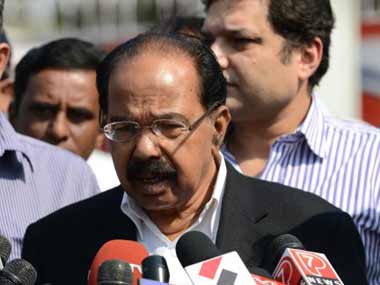Oil ministerM Veerappa Moilyis leaving no stone unturned to bring down the country’s oil import bill, which has a huge bearing on the current account deficit. The Indian financial markets have been in a turmoil as fears of a widening CAD have prompted foreign investors to exit Indian assets for safer bets.
Current account falls into a deficit zone when a country’s spend on imports exceeds its earning from exports.
India imports over 70 percent of its oil requirement. In the absence of a rise in exports, the trade and current account deficits have widened, piling up pressure on the rupee which is already weak.
On Friday, Moily had sent a detailed note to the Prime Minister on shaving up to $20 billion from the 2012-13 oil import bill, detailing various possible steps the government can take.
[caption id=“attachment_1078227” align=“alignleft” width=“380”]
 On Friday, Moily had sent a detailed note to the Prime Minister on shaving up to $20 billion from the 2012-13 oil import bill, detailing various possible steps the government can take.[/caption]
On Friday, Moily had sent a detailed note to the Prime Minister on shaving up to $20 billion from the 2012-13 oil import bill, detailing various possible steps the government can take.[/caption]
Here are the four proposals that Moily sent to Prime Ministerto help the government save on foreign exchange
1. Importing more oil from Iran:Moily suggested that India may save nearly $8.5 billion (about Rs 57,000 crore) by importing cheaper crude oil from Iran which faces UN sanctions for its nuclear programme. The US and EU sanctions have more than halved Iran’s oil exports. Earlier, the country used to export about 2.2 million barrels per day (bpd).
Impact Shorts
More ShortsMoily has said that so far this year, India has imported 2 million tonnes of crude from Iran and an additional 11 million tonnes would pare the forex outgo by almost $8.5 billion, assuming oil price at $105.
Given India’s payment to Iran for its oil is currently being made in rupees, in order to bypass US imposed sanctions on sending euros and dollars to the nation, the rising dollar may make Iran’s oil imports seem more attractive. The increasing imports from Iran could also help arrest the fall of the rupee since oil importing companies would not need to buy as many dollars.
**2. Steeper fuel price increase:**Even as petrol price was raised by Rs 2.35 a litre and diesel got its monthly dose of 50 paise hike per litre on Saturday, the petroleum ministry is batting for a substantial rise in diesel, domestic LPG and kerosene prices. According to media reports, diesel prices may see a one-time hike of R. 3-5 per litre, kerosene of Rs 2 and LPG of Rs 50 per cylinder.This is because a 25 percent drop in rupee has resulted in losses on diesel sales widening to Rs 12.12 per litre despite prices being raised by 50 paise a litre per month since January.
A further increase in oil prices is expected after the current Parliament session ends on 6 September.However, a sharp rise in diesel prices just before general elections is seen as a largely unpopular move as it will stoke inflation, leading to possibly higher interest rates.
But, at the same time, if the government did not increase the prices, it will push up its subsidy burden and in turn its fiscal deficit to unmanageable levels. “The current under recovery figures that Moily has projected are 13 per cent higher than the previous year’s Rs 1,61,309 crore,” said a Business Standard report.
3. Moral suasion: Moily targets to save $2.5 billion in petroleum product consumption via conversation campaigns, which will be launched by the Petroleum Conservation and Research Association, an arm of the ministry. The plan is to run a six-week campaign from 16 September to promote conservation of petrol, diesel and LPG. Thespecial drive, estimated to cost Rs 17.5 crore, would include mass media campaign, street plays, street intersection activities, drivers’ training programmes and hoardings at retail outlets.
**4. Night curfew on **auto fuel:****The petroleum ministry is planning to do away with 24-hour petrol pumps in cities, the most controversial of all the moves Moily has proposed. As per this plan, the government will allow the fuel filling stations to remain open only from 8 am to 8 pm.
Currently most pumps have flexible hours that extend up to 11 pm while some stay open round the clock.However, shutting of petrol pumps at night is likely to lead to black markets at night for higher prices.
“This idea to keep petrol pumps closed from 8 pm to 8 am is a very ill advised idea. It’s not going to work. This idea if implemented will create black market and panic. You can put some night surcharge but don’t stop selling it,” said petroleum sector analyst Narendra Taneja in an interview with CNN IBN.
Interestingly, the only solution to the whole issue is complete decontrol of the fuels. Even on petrol, which is deregulated in principle, oil companies are suffering losses. This is because the final decision on price increase still rests with the government.
A complete deregulation is, however, the most unpopular decision. The government would not want to take it in a pre-election year. Not surprisingly, that is not among the proposals.
)